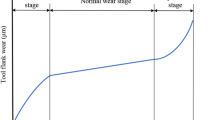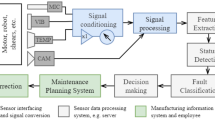Abstract
The need to monitor tool wear is crucial, particularly in advanced manufacturing industries, as it aims to maximise the lifespan of the cutting tool whilst guaranteeing the quality of workpiece to be manufactured. Although there have been many studies conducted on monitoring the health of cutting tools under a specific cutting condition, the monitoring of tool wear across multi-cutting conditions still remains a challenging proposition. In addressing this, this paper presents a framework for monitoring the health of the cutting tool, operating under multi-cutting conditions. A predictive model, using advanced machine learning methods with multi-feature multi-model ensemble and dynamic smoothing scheme, is developed. The applicability of the framework is that it takes into account machining parameters, including depth of cut, cutting speed and feed rate, as inputs into the model, thus generating the key features for the predictions. Real data from the machining experiments were collected, investigated and analysed, with prediction results showing high agreement with the experiments in terms of the trends of the predictions as well as the accuracy of the averaged root mean squared error values.








Similar content being viewed by others
References
Benkedjouh, T., Medjaher, K., Zerhouni, N., & Rechak, S. (2015). Health assessment and life prediction of cutting tools based on support vector regression. Journal of Intelligent Manufacturing, 26(2), 213–223.
Fish, R. K., Ostendorf, M., Bernard, G. D., & Castanon, D. A. (2003). Multilevel classification of milling tool wear with confidence estimation. IEEE Transactions on Pattern Analysis and Machine Learning, 25(1), 75–85.
Geramifard, O., Xu, J. X., Zhou, J. H., & Li, X. (2011). Continuous health condition monitoring: A single hidden semi-Markov model approach. In IEEE Conference on Prognostics and Health Management (PHM) (pp. 1–10). IEEE.
Geramifard, O., Xu, J. X., Zhou, J. H., & Li, X. (2012). A physically segmented hidden Markov model approach for continuous tool condition monitoring: Diagnostics and prognostics. IEEE Transactions on Industrial Informatics, 8(4), 964–973.
Guyon, I., & Elisseeff, A. (2003). An introduction to variable and feature selection. Journal of Machine Learning Research, 3, 1157–1182.
Hauke, Jan, & Kossowski, Tomasz. (2011). Comparison of values of Pearson’s and Spearman’s correlation coefficients on the same sets of data. Quaestiones geographicae, 30(2), 87–93.
ISO 3685:1993. (1993). Tool-life testing with single-point turning tools (2nd ed.). Geneva: International Organization for Standardization.
Kalidasan, R., Ramanuj, V., Sarma, D. K., & Senthilvelan, S. (2014). Influence of cutting speed and offset distance over cutting tool vibration in multi-tool turning process. In Advanced materials research (vol. 984, pp. 100–105), New York: Trans Tech Publications.
Kong, D., Chen, Y., & Li, N. (2018). Gaussian process regression for tool wear prediction. Mechanical Systems and Signal Processing, 1(104), 556–574.
Kong, D., Chen, Y., Li, N., & Tan, S. (2017). Tool wear monitoring based on kernel principal component analysis and v-support vector regression. The International Journal of Advanced Manufacturing Technology., 89(1–4), 175–190.
Lenz, J., & Westkaemper, E. (2017). Wear prediction of woodworking cutting tools based on history data. Procedia CIRP, 1(63), 675–679.
Li, X., Er, M. J., Ge, H., Gan, O. P., Huang, S., Zhai, L. Y., Linn, S., & Torabi, A. J. (2012). Adaptive network fuzzy inference system and support vector machine learning for tool wear estimation in high speed milling processes. In IECON 2012-38th annual conference on ieee industrial electronics society (pp. 2821–2826). IEEE.
Murua, M., Suárez, A., de Lacalle, L. N., Santana, R., & Wretland, A. (2018). Feature extraction-based prediction of tool wear of Inconel 718 in face turning. Insight-Non-Destructive Testing and Condition Monitoring., 60(8), 443–450.
Pang, C. K, Zhou, J. H., Zhong, Z. W., & Lewis, F. L. (2010). Tool wear forecast using Dominant Feature Identification of acoustic emissions. In IEEE international conference on control applications (CCA) (pp. 1063–1068). IEEE.
Pratama, M., Er, M. J., Li, X., Gan, O. P., Oentaryo, R. J., Linn, S., Zhai, L., & Arifin, I. Tool wear prediction using evolutionary dynamic fuzzy neural (EDFNN) network. In IECON 2011-37th annual conference on IEEE industrial electronics society (pp. 4739–4744). IEEE.
Ren, Q., Balazinski, M., & Baron, L. (2009). Uncertainty prediction for tool wear condition using type-2 TSK fuzzy approach. In IEEE international conference on systems, man and cybernetics, 2009. SMC (pp. 660–665). IEEE.
Siddhpura, A., & Paurobally, R. (2013). A review of flank wear prediction methods for tool condition monitoring in a turning process. The International Journal of Advanced Manufacturing Technology, 65(1), 371–393.
Taylor, F. W. (1907). On the art of cutting metals. New York: The American Society of Mechanical Engineers.
Wang, J., Wang, P., & Gao, R. X. (2015). Enhanced particle filter for tool wear prediction. Journal of Manufacturing Systems., 31(36), 35–45.
Wu, Q., Yang, X., & Zhou, Q. (2012). Pattern recognition and its application in fault diagnosis of electromechanical system. Journal of Information and Computational Science, 9(8), 2221–2228.
Yang, F., Habibullah, M. S., Zhang, T., Xu, Z., Lim, P., & Nadarajan, S. (2016). Health index-based prognostics for remaining useful life predictions in electrical machines. IEEE Transactions on Industrial Electronics, 63(4), 2633–2644.
Yousefi, R., Gorjizadeh, A., & Mikaeil, R. (2011). The effect of machining parameters on force signal and tool wear in stone cutting. In AIP conference proceedings (vol. 1315, no. 1, pp. 961–966), AIP.
Zhang, G., & Guo, C. (2016). Modeling flank wear progression based on cutting force and energy prediction in turning process. Procedia Manufacturing., 1(5), 536–545.
Zhang, J., Starly, B., Cai, Y., Cohen, P. H., & Lee, Y. S. (2017). Particle learning in online tool wear diagnosis and prognosis. Journal of Manufacturing Processes., 1(28), 457–463.
Zhang, H., Zhang, C., Zhang, J., & Zhou, L. (2014). Tool wear model based on least squares support vector machines and Kalman filter. Production Engineering, 8(1–2), 101–109.
Zhao, R., Wang, J., Yan, R., & Mao, K. (2016). Machine health monitoring with LSTM networks. In 2016 10th international conference on sensing technology (ICST) (pp. 1–6). IEEE.
Zhou, J. H., Pang, C. K., Zhong, Z. W., & Lewis, F. L. (2011). Tool wear monitoring using acoustic emissions by dominant-feature identification. IEEE Transactions on Instrumentation and Measurement, 60(2), 547–559.
Zhu, M., Xiao, P., & Zhang, C. (2016). A modeling method for monitoring tool wear condition based on adaptive dynamic non-bias least square support vector machine. In International conference on system reliability and science (ICSRS) (pp. 53–59). IEEE.
Author information
Authors and Affiliations
Corresponding author
Additional information
Publisher's Note
Springer Nature remains neutral with regard to jurisdictional claims in published maps and institutional affiliations.
Rights and permissions
About this article
Cite this article
Shen, Y., Yang, F., Habibullah, M.S. et al. Predicting tool wear size across multi-cutting conditions using advanced machine learning techniques. J Intell Manuf 32, 1753–1766 (2021). https://doi.org/10.1007/s10845-020-01625-7
Received:
Accepted:
Published:
Issue Date:
DOI: https://doi.org/10.1007/s10845-020-01625-7




